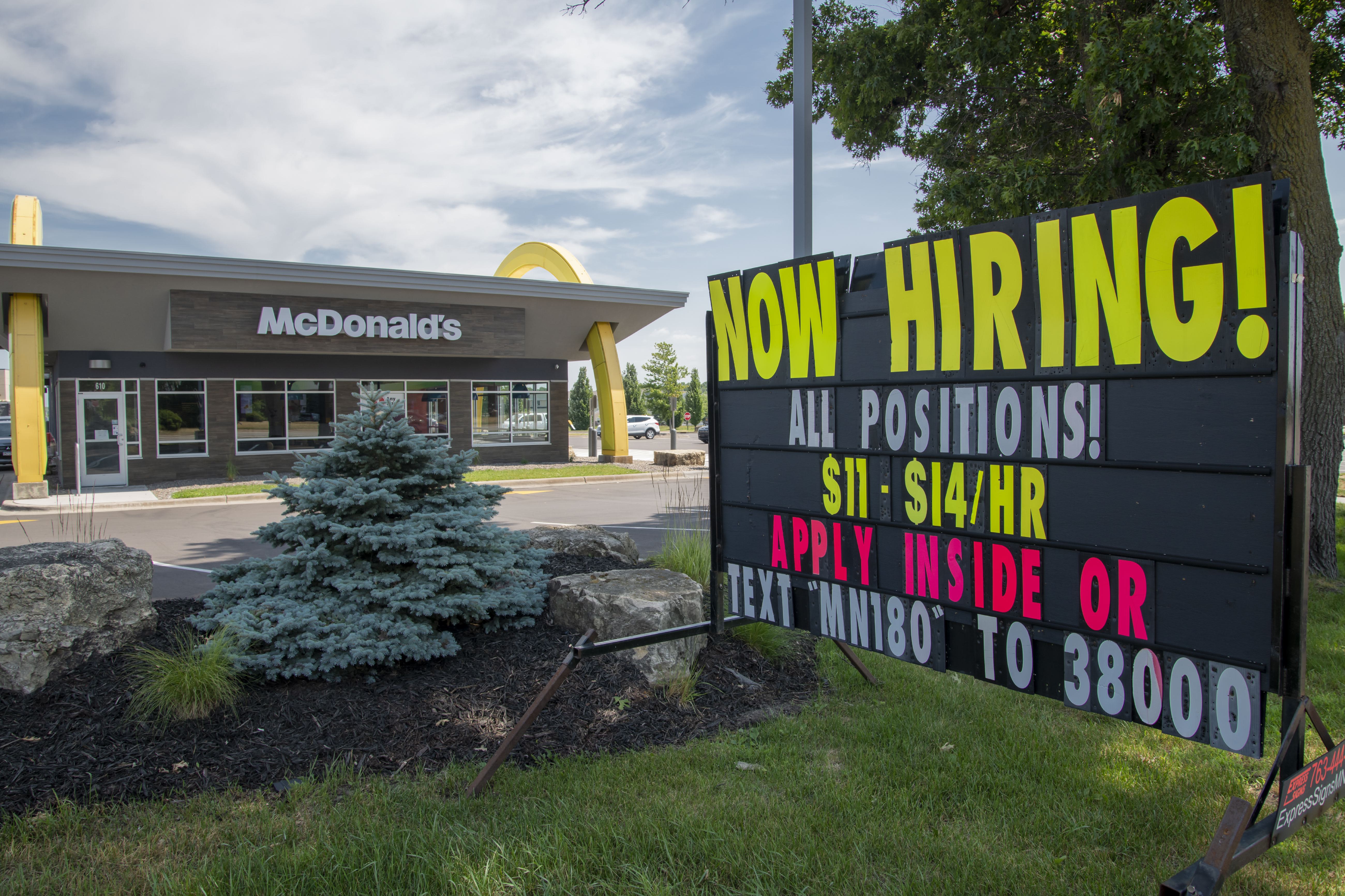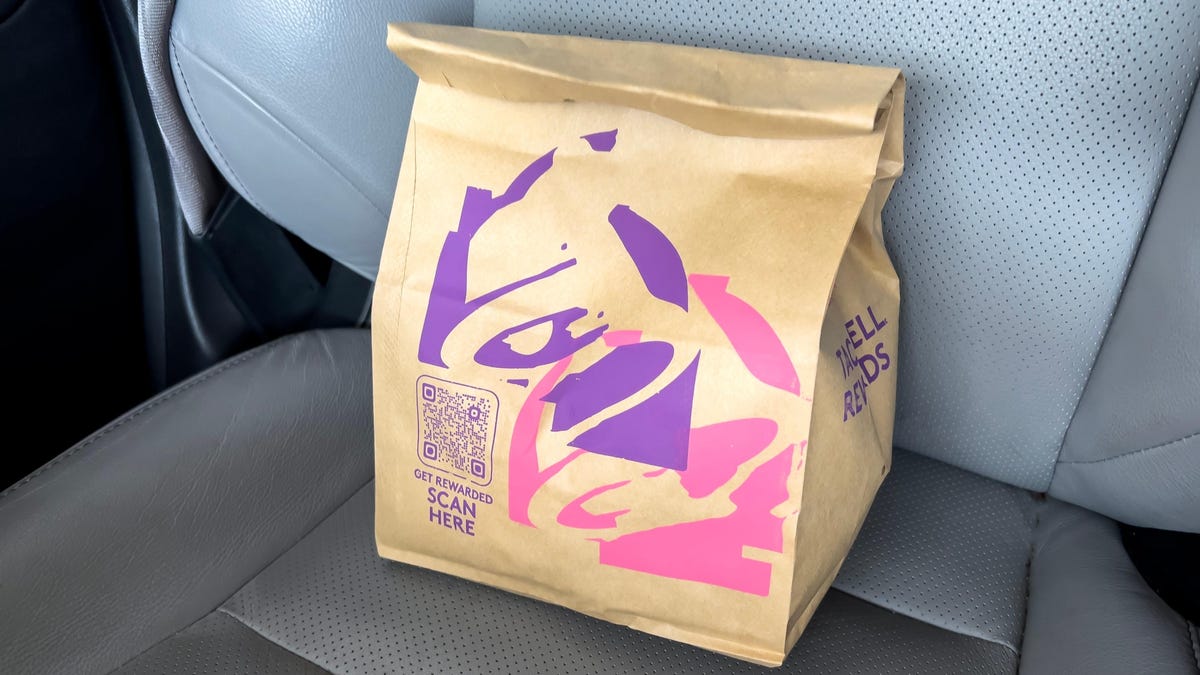Lino Lakes, Minnesota, Help wanted sign at McDonalds with great starting pay.
Michael Siluk | Getty Images
Quick service and fast-food restaurants are facing several headwinds when it comes to solving their labor problems. The pressures have been mounting throughout the year. Seventy-eight percent of restaurant operators said that recruiting and retaining employees was their top challenge in a National Restaurant Association survey in July — in January, only 8% said that was their top challenge.
Overall employment in food services and drinking places has seen marginal improvements in recent months, with nearly 120,000 workers added in October, but the industry only added a net 150,000 employees from July to October, according to the Labor Department, and there were nearly 800,000 less workers in October 2021 than there were in February 2020.
That is layered on top of the broader challenges that every industry is facing to find willing workers amid record numbers of job openings. Half of the nation’s workers describe their workplaces being as understaffed, according to a CNBC|Momentive Workforce Survey, with those workers more likely to say they’ve recently thought about quitting.
Restaurants have looked to both attract and retain workers in a variety of ways, from cutting operating hours to offering better benefits. Wages also saw an increase, with restaurant workers seeing wages over $15 an hour for the first time this summer.
Still, many restaurants have struggled to both hire and retain workers in a sector typically known for high levels of turnover. The U.S. Bureau of Labor Statistics reported that there were roughly 1.7 million job openings in the leisure and hospitality sector that includes food service workers in August, compared to approximately 1.2 million unemployed workers.
Here are what executives at some of the biggest fast-food and fast-casual restaurants have been saying on recent earnings calls about how labor shortages are impacting their businesses and what they see ahead.
Challenge in finding the workers they need
“There is wage inflation,” he said. “Our franchisees are increasing wages; they’re over 10% wage inflation year-to-date [and] we’re seeing in our [McDonald’s operated] restaurants were up over 15% on wages, and that is having some helpful benefits, certainly, the higher wages that you pay it allows you to stay competitive. But we’re also seeing that is just, it’s very challenging right now in the market to find the level of talent that you need.”
Not being fully staffed is impacting McDonald’s locations in several ways, Kempcsinski said.
“We might be dialing back late night for example from what we would ordinarily be doing,” he said. “It’s also putting some pressure around speed of service, where we are down a little bit on speed of service over the last year-to-date and [what] we did in the last quarter.”
However, Kempcsinski said the labor shortage issue was “not unsolvable either.” He noted that in corporate-owned McDonald’s locations, there has been a strong focus to provide shift managers with training to keep the existing crew engaged and motivated.
“But certainly, I was hoping and expecting that we’re going to see the situation improved, maybe a little bit more quickly than what’s materialized,” he said. “I think it is going to continue to be a difficult environment for the next several quarters.”
Impact of boosting wages
“As seen in nearly every industry and especially in hospitality, staffing our Shacks remains challenging,” Shake Shack CEO Randy Garutti said on the company’s third quarter earnings call.”
Garutti recognized the company’s efforts that were announced over the summer, which also included retention bonuses and “leadership development initiatives,” but also noted how that has impacted the company’s returns.
“We remain below optimal staffing levels and are working harder than ever to attract and retain the strongest teams,” he said. “You can count on us to invest in wages, bonuses and incentives that take care of our teams and offer the kind of career opportunities our teams need. All of this will come at a cost, and you’ve seen this in our Q3 numbers, and you should expect this impact to remain a pressure near term as we work to elevate our people.”
Garutti said that he expects “continued pressure across our labor lines for the foreseeable future as we navigate industrywide staffing challenges.”
For Wendy’s, labor rate inflation was cited as one of the reasons that company restaurant margins decreased year-over-year in its third quarter, and it said it expects elevated labor inflation next year.
“We’re starting to see staffing improve but still not to the level that we need it to be to really drive all the opportunity that’s out there in front of us, and that’s going to take a little bit of time because that labor market is not going to snap back overnight,” Wendy’s CEO Todd Penagor said on the company’s third quarter earnings call. “And you’re seeing that in some of the labor inflation…it’s just costing a little bit more, but there’s a good return on that investment in our people because we can drive a great customer experience and drive a lot more business because there’s a lot more business to be had.”
Lack of workers causing a reduction in operating hours
Like McDonald’s, Burger King and Popeyes parent company Restaurant Brands International is also seeing some of its locations having to reduce hours.
“We saw about an average of [a] one hour reduction in operating hours at Popeyes during this quarter relative to pre-pandemic levels, which obviously, has an impact, and that was disproportionately impacting our late-night business, which historically over indexes in family and which comes along with a pretty high check,” CEO José Cil said on the company’s third quarter earnings call.
Restaurant Brands International CFO Matthew Dunnigan said the company is “looking at ways we can simplify life in the restaurants” to address staffing shortages, which could include changing menus or processes.
Yum Brands, which operates brands like KFC, Pizza Hut and Taco Bell, has also seen worker shortages limit what hours its restaurants are open.
“U.S. labor availability remains tight across most industries, driving wage inflation and staffing challenges that have resulted in a small number of our stores limiting operating hours, particularly during the early morning and late-night,” Yum Brands CFO Chris Turner said on the company’s third quarter earnings call.
Trying to solve the labor problem
“You look at the number of open job positions across the U.S. right now. It’s a pretty staggering number and a lot of those are certainly related to our industry,” he said.
Allison noted several factors as to why he thinks the restaurant industry has seen a shortage of workers.
“Most certainly there have been a significant number of Americans who have removed themselves from the workforce over the course of Covid and haven’t come back yet. If you look at labor force participation rates, they are down rather significantly from pre-Covid,” he said. “We have not seen it yet as much as we would like, but we do expect there to be some relaxing of the labor market as Covid continues to subside and as folks get more comfortable, have more options to care for their children, etc., to get back out into the workforce.”
Allison also pointed to declining immigration trends amid slowing population growth in the U.S. “We in our industry, and a number of others, will need to see more immigration, I think, to continue to have a robust workforce, particularly in the younger age groups,” he said.
There are some factors that restaurants can control, like wages, Allison said. But there also needs to be a focus on making jobs in the industry “easier and more appealing.”
“How do we make it easier; how do we keep drivers in their cars 100% of the time and not have them do tasks inside the stores that they don’t enjoy doing and that don’t drive tips for them; how do we bring more technology into the stores to allow us to operate more efficiently with fewer labor hours per unit of sales,” he said.
Chipotle CEO Brian Niccol noted on the company’s third quarter earnings call that “obviously, a fully staffed restaurant outperforms an understaffed restaurant,” saying that the company has looked to win the “hiring competition” through competitive wages, benefits and a focus on worker development.
“At the end of the day, I wish all our restaurants were fully staffed and I know we’re missing sales because not all of them are fully staffed. So, there is still upside in getting our staffing solved every single restaurant,” he said.
“I wish every restaurant was staffed, it’d be a better job for everybody, and it’d be a better experience for every customer,” Niccol said.
Missed this year’s CNBC’s At Work summit? Access the full sessions on demand at https://www.cnbcevents.com/worksummit/











